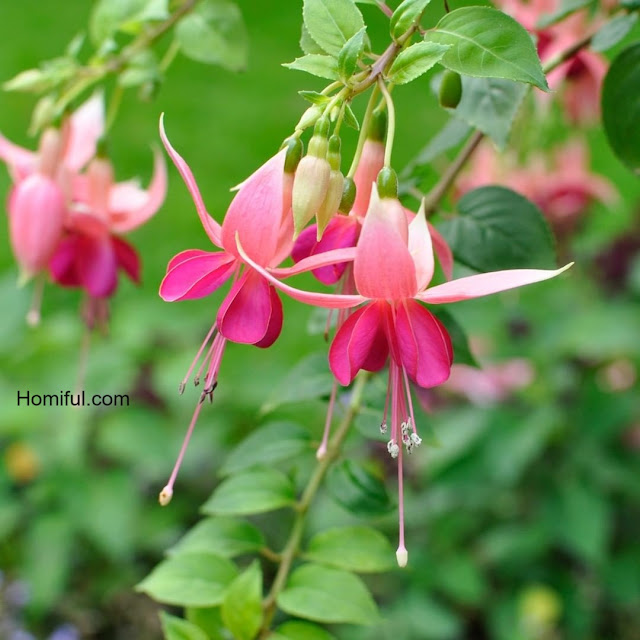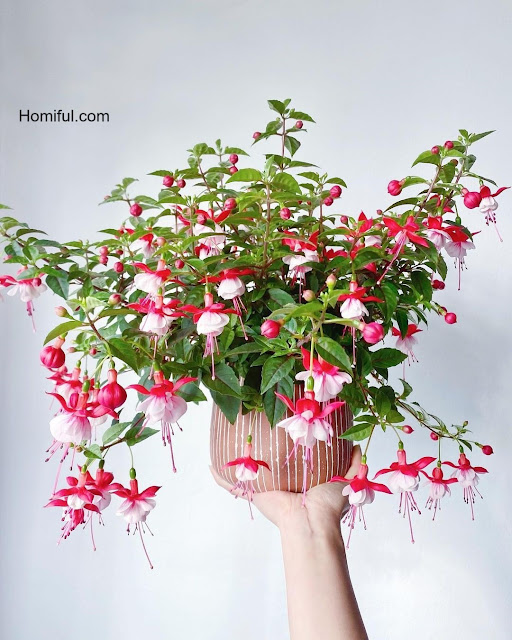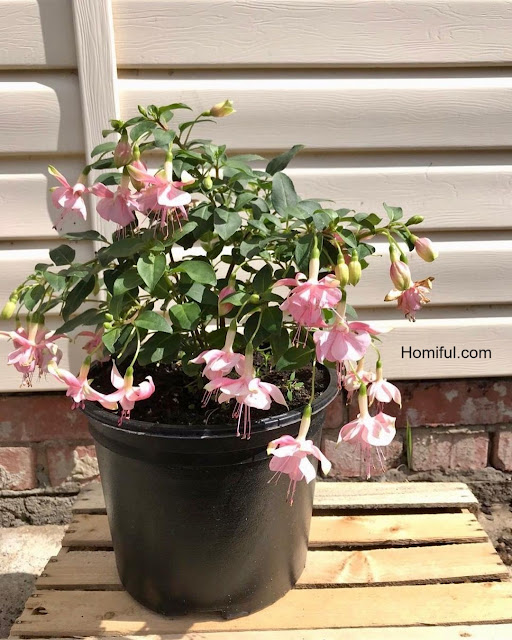 |
| Plant Ideas: How To Grow Fuchsias |
Homiful.com -- Fuchsias produce dozens of vividly colored dangling, teardrop-shaped, single or double blooms from trailing stems from spring through fall, and they do so in shaded conditions where most plants struggle.
With their gorgeous, drooping petals hanging down like so many crystals on a fine chandelier, fuchsias are a fantastic essential for hanging baskets.
Quick Facts about Fuchsia
 |
| @hypericumhidcote |
Botanical Name : Fuchsia (Group)
Common Names : Fuchsia
Family Name : Onagraceae
Plant Type : Shrub, annual
Mature Size : 1 to 2 ft. tall, with a similar spread
Sun Exposure : Partial shade
Soil Type : Moist but well-drained
Soil pH : Neutral to acidic
Bloom Time : Spring, summer, fall
Flower Color : Red, pink, white, violet, purple
Hardiness Zones : 10 thru 11
Native Area : Caribbean, South America
Plant Care
 |
| @inselmainau |
While these plants can be long-term garden plants in warm areas, fuchsias usually grown as outdoor container plants, either as annuals and abandoned when the weather turns cold or kept within and nurtured in bright light and controlled circumstances throughout the winter. Fuchsias are considered a simple plant to grow in container gardens, despite being little picky about moisture and temperature.
Light : These plants thrive in conditions ranging from partial to complete shade. They like strong indirect light rather than direct sunshine when grown indoors.
Soil : Fuchsia plants require nutrient-rich soil with a pH of 6 to 7 in order to grow. Fuchsia plants like soil that is regularly wet (but not soggy) and has a high organic matter ratio. At the same time, the soil should drain effectively.
Water : Fuchsias prefer moist but not soggy conditions. They thrive in humidity, so if you live somewhere dry, they will be more challenging to grow and care.
Temperature and Humidity : Fuchsias thrive in temperatures ranging from 55 to 80 degrees Fahrenheit, while some heat-tolerant varieties may bloom in temperatures as high as 90 degrees Fahrenheit. There are also a few shrub-like kinds that can withstand cold temperatures.
Fertilizer : Fuchsias have a huge lack of food across the flowering season, so feed them on a regular basis with diluted liquid fertilizer. A mixture of fish emulsion and seaweed can be good.
Types of Fuchsia
 |
| @joyfulhomebody |
There are many of varieties to choose from, depending on your preferences for blossom color and growing habits. Consider some of these perfect choices:
- 'Swingtime' is a trailing cultivar with white inner petals that are ruffled and bordered by vivid red outer sepals.
- The shrubby, upright 'Army Nurse' has purple flower petals encircled by scarlet sepals. It looks great in big pots or as a landscape plant.
- The trailing variety 'Rapunzel' has purple and pinkish-white blooms. Its stems can extend for up to two feet.
- 'Phyllis' is a tall cultivar with deep red petals and lighter rose-red sepals.
Pruning and Propagating
.jpg) |
| @pipiflower_ |
Pruning a fuchsia plant on a regular basis helps keep it blooming and healthy. It is also acceptable to prune severely. It will recover and be better as a result. Remove thin or brittle growth from trailing fuchsia at any time. A little trim in the early fall and spring would be beneficial to clear off any dead stems on bushy perennial fuchsia.
Fuchsia plants are easiest to propagate by spring stem cuttings.
- Remove a two- to four-inch section of the stem tip, immediately above the third pair of leaves.
- Remove the bottom leaves and put the cutting's end in rooting hormone.
- Plant the cutting in a tray or container filled with seed-starter mix or a sand, perlite, and peat moss mixture.
- Place the pot in a warm spot and cover it with loose, clear plastic.
- Roots should appear in three to four weeks, at which point you can remove the cover.
- When fresh leaf growth appears on the cutting, repot the fuchsia in a larger container and transplant it outside.
Potting and Repotting
 |
| @pipiflower_ |
Here are some fuchsia repotting tips:
- Because fuchsia is susceptible to root rot, it requires a fast-draining potting soil and excellent drainage, therefore ensure that containers have appropriate drainage holes and that the potting medium drains properly.
- To avoid losing soil via drainage holes during watering, cover the holes with plastic screening before filling the container with soil.
- Allow room between the container's top and the soil line. Fill the container only halfway with dirt.
Problems, Pests, & Diseases
.jpg) |
| @svetlana_fuchsia |
Fuchsia plants are rarely affected by disease. Fuchsia hybrids are particularly well-known for their reliability and resilience to common garden pests. However, insects such as mealy bugs and aphids may visit the plant.
Inspect each plant carefully on a weekly basis for indications of damage, especially at the junctures of stem and leaf. When required, apply neem oil and insecticidal soap to the plants. You may introduce some helpful insects to keep the nasty bugs at bay.
How to Get Fuchsia to Bloom
 |
| @svetlana_fuchsia |
Remember that fuchsia only blooms on new growth. When a bloom starts to fade, pinch it back to allow fresh growth. Most of the time, you'll be rewarded with a fresh, vivid blossom within a few weeks. If you keep pinching back the petals as needed, fuchsia can rebloom in a single season.
If you haven't seen fresh blossoms after six weeks, trim the stem back to the first strong node and give it more time to grow.
Like this article? Don't forget to share and leave your thumbs up to keep support us. Stay tuned for more interesting articles from us in the future!
For those of you looking for a minimalist home design that ranges from simple to modern. Please leave your message and comments on Home Lovers on Facebook.
This article should be useful for those of you looking for design ideas and house plans.
Hopefully, you will find it easier to create your ideal home.
Don't forget to share it with your friends and family so that it can help others.
Author : Rieka
Editor : Munawaroh
Source : Various sources
Homiful.com is a collection of minimalist home designs and floor plans ranging from simple to modern. There are also several home decorating tips and tricks in various themes. Our main theme is the design and layout of the house, as well as the inspiration for the living room, bedroom, family room, bathroom, house prayer room, house terrace, and child's bedroom.


